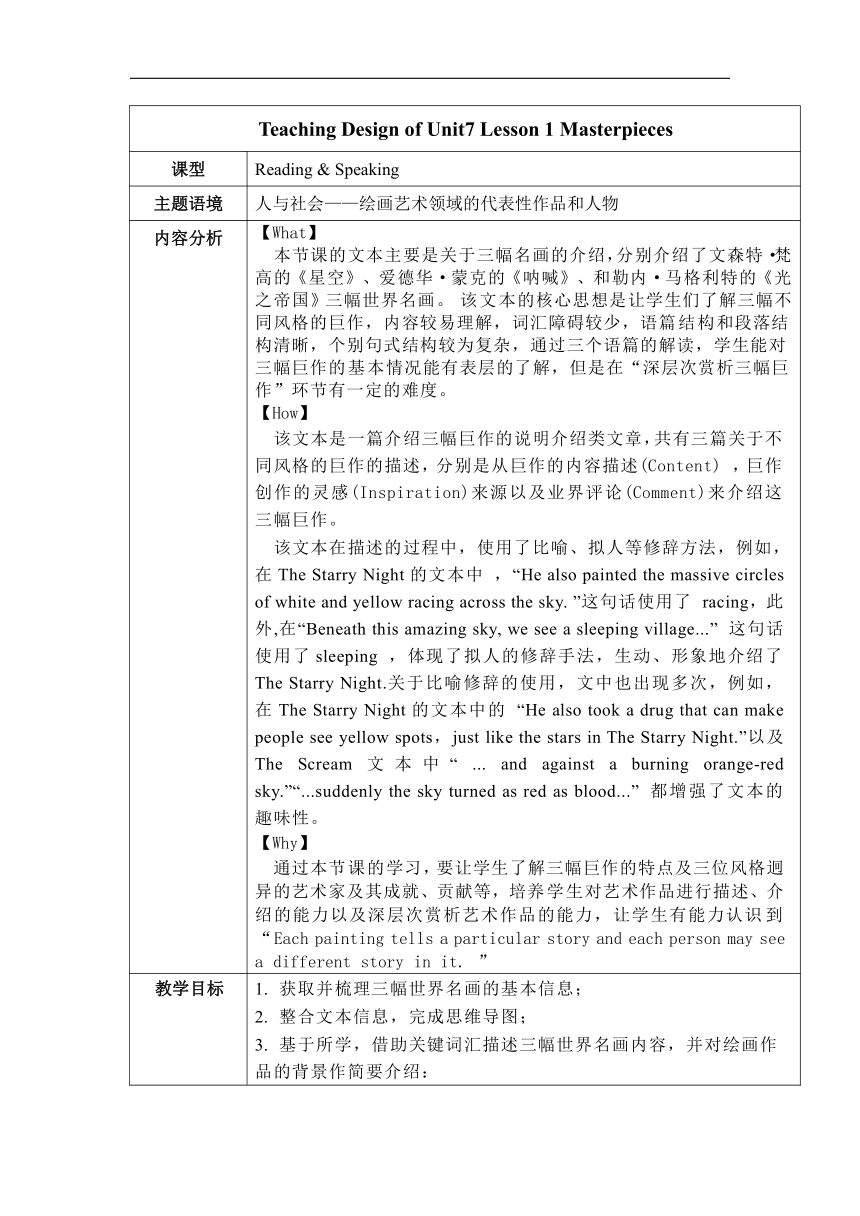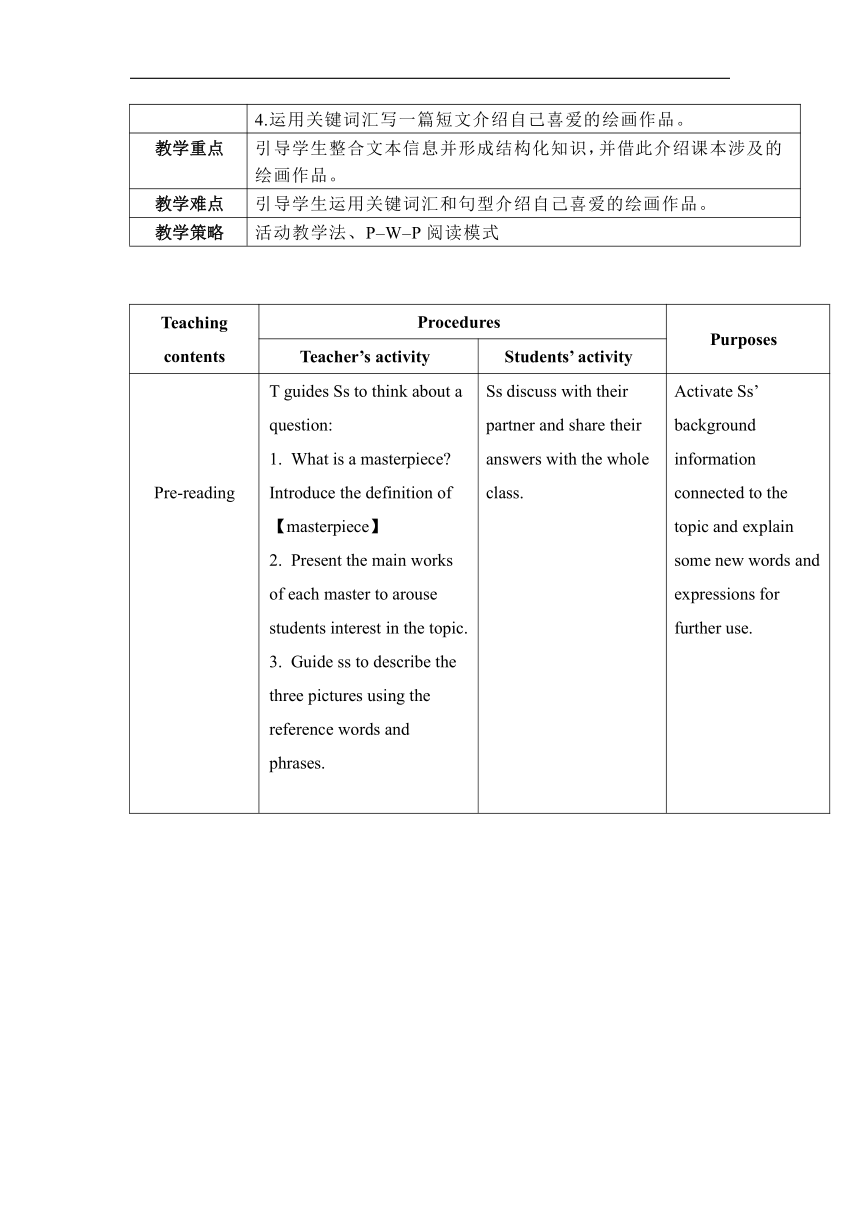北师大版(2019)必修 第三册Unit 7 Art Lesson 1 Masterpieces教学设计(表格式)
文档属性
| 名称 | 北师大版(2019)必修 第三册Unit 7 Art Lesson 1 Masterpieces教学设计(表格式) |  | |
| 格式 | docx | ||
| 文件大小 | 23.6KB | ||
| 资源类型 | 教案 | ||
| 版本资源 | 北师大版(2019) | ||
| 科目 | 英语 | ||
| 更新时间 | 2024-03-13 14:50:39 | ||
图片预览



文档简介
Teaching Design of Unit7 Lesson 1 Masterpieces
课型 Reading & Speaking
主题语境 人与社会——绘画艺术领域的代表性作品和人物
内容分析 【What】 本节课的文本主要是关于三幅名画的介绍,分别介绍了文森特·梵高的《星空》、爱德华·蒙克的《呐喊》、和勒内·马格利特的《光之帝国》三幅世界名画。 该文本的核心思想是让学生们了解三幅不同风格的巨作,内容较易理解,词汇障碍较少,语篇结构和段落结构清晰,个别句式结构较为复杂,通过三个语篇的解读,学生能对三幅巨作的基本情况能有表层的了解,但是在“深层次赏析三幅巨作”环节有一定的难度。 【How】 该文本是一篇介绍三幅巨作的说明介绍类文章,共有三篇关于不同风格的巨作的描述,分别是从巨作的内容描述(Content) ,巨作创作的灵感(Inspiration)来源以及业界评论(Comment)来介绍这三幅巨作。 该文本在描述的过程中,使用了比喻、拟人等修辞方法,例如,在The Starry Night的文本中 ,“He also painted the massive circles of white and yellow racing across the sky. ”这句话使用了 racing,此外,在“Beneath this amazing sky, we see a sleeping village...” 这句话使用了sleeping ,体现了拟人的修辞手法,生动、形象地介绍了 The Starry Night.关于比喻修辞的使用,文中也出现多次,例如,在The Starry Night的文本中的 “He also took a drug that can make people see yellow spots,just like the stars in The Starry Night.”以及 The Scream文本中“ ... and against a burning orange-red sky.”“...suddenly the sky turned as red as blood...” 都增强了文本的趣味性。 【Why】 通过本节课的学习,要让学生了解三幅巨作的特点及三位风格迥异的艺术家及其成就、贡献等,培养学生对艺术作品进行描述、介绍的能力以及深层次赏析艺术作品的能力,让学生有能力认识到 “Each painting tells a particular story and each person may see a different story in it. ”
教学目标 1. 获取并梳理三幅世界名画的基本信息; 2. 整合文本信息,完成思维导图; 3. 基于所学,借助关键词汇描述三幅世界名画内容,并对绘画作品的背景作简要介绍: 4.运用关键词汇写一篇短文介绍自己喜爱的绘画作品。
教学重点 引导学生整合文本信息并形成结构化知识,并借此介绍课本涉及的绘画作品。
教学难点 引导学生运用关键词汇和句型介绍自己喜爱的绘画作品。
教学策略 活动教学法、P–W–P阅读模式
Teaching contents Procedures Purposes
Teacher’s activity Students’ activity
Pre-reading T guides Ss to think about a question: What is a masterpiece Introduce the definition of 【masterpiece】 Present the main works of each master to arouse students interest in the topic. Guide ss to describe the three pictures using the reference words and phrases. Ss discuss with their partner and share their answers with the whole class. Activate Ss’ background information connected to the topic and explain some new words and expressions for further use.
While reading Activity 1 Fast-reading 1.What are these three descriptions mainly about A. Three famous paintings. B. Three famous painters. C. Three interesting stories. D. Three interesting books. 2. What is the text type of the passage A. Narration(记叙文). B. Argumentative Essay(议论文). C. Expository Writing(说明文). D. Practical writing(应用文). Ss go through the passage quickly to find out the key information. Guide Ss to realise the theme and the writing style of the text.
While-reading Activity 2 Careful-reading for details T invites Ss to read the description of The Starry Night carefully and answer: 1. What does The Starry Night not include A. Moon and stars. B. White and yellow circles and amazing sky. C. A sleeping village and a lonely tree. D. A white river with circles. 2.What may have affected/inspired Van Gogh’s special way of painting A. His unusual use of colour. B. His mental illness. C. The drugs he took. D. Both B and C. 3. What did the artist think or say about The Starry Night II. Read the description of The Scream carefully and fill in the blanks: 2. What might be the cause of such a strange picture according to experts A. His mental problems. B. The thin figure he saw on the bridge. C. The burning fire. D. The scream a person let out Ⅲ.Read the description of The Empire of Light carefully and complete: 1. Try to tell true(T)or false(F). (1) The Empire of Light was painted many times in 2 years.( ) (2) It painted a beautiful house in total darkness of the night.( ) 2. What did he say about the painting 3. What did viewers think about the painting Ss read carefully and complete each activity in order. Ss get the detailed information of the texts and fulfil each activity.
Post-reading Activity I Make a short speech T asks Ss to review the text and think about the descriptive structure of how to introduce a painting.(using the reference) Ss work in group of 4 to work out how to describe the content of a painting and depict the emotion behind each painting by using the descriptive words. Ss get to know the structure of the introduction of an art work and put them to use.
Conclusion T invites Ss to read the quotes from Michelangelo: A man paints with his brain and not his hands.
Ss use the quotes to help them think further. Consolidate the language Ss have learnt in the class.
Homework Write a passage to introduce one of your favorite paintings and tell us the emotion/symbolism shown in it. Ss finish it after class. Apply the language points related to the topic and the structure of the text to their writing and deepen Ss’ understanding.
课型 Reading & Speaking
主题语境 人与社会——绘画艺术领域的代表性作品和人物
内容分析 【What】 本节课的文本主要是关于三幅名画的介绍,分别介绍了文森特·梵高的《星空》、爱德华·蒙克的《呐喊》、和勒内·马格利特的《光之帝国》三幅世界名画。 该文本的核心思想是让学生们了解三幅不同风格的巨作,内容较易理解,词汇障碍较少,语篇结构和段落结构清晰,个别句式结构较为复杂,通过三个语篇的解读,学生能对三幅巨作的基本情况能有表层的了解,但是在“深层次赏析三幅巨作”环节有一定的难度。 【How】 该文本是一篇介绍三幅巨作的说明介绍类文章,共有三篇关于不同风格的巨作的描述,分别是从巨作的内容描述(Content) ,巨作创作的灵感(Inspiration)来源以及业界评论(Comment)来介绍这三幅巨作。 该文本在描述的过程中,使用了比喻、拟人等修辞方法,例如,在The Starry Night的文本中 ,“He also painted the massive circles of white and yellow racing across the sky. ”这句话使用了 racing,此外,在“Beneath this amazing sky, we see a sleeping village...” 这句话使用了sleeping ,体现了拟人的修辞手法,生动、形象地介绍了 The Starry Night.关于比喻修辞的使用,文中也出现多次,例如,在The Starry Night的文本中的 “He also took a drug that can make people see yellow spots,just like the stars in The Starry Night.”以及 The Scream文本中“ ... and against a burning orange-red sky.”“...suddenly the sky turned as red as blood...” 都增强了文本的趣味性。 【Why】 通过本节课的学习,要让学生了解三幅巨作的特点及三位风格迥异的艺术家及其成就、贡献等,培养学生对艺术作品进行描述、介绍的能力以及深层次赏析艺术作品的能力,让学生有能力认识到 “Each painting tells a particular story and each person may see a different story in it. ”
教学目标 1. 获取并梳理三幅世界名画的基本信息; 2. 整合文本信息,完成思维导图; 3. 基于所学,借助关键词汇描述三幅世界名画内容,并对绘画作品的背景作简要介绍: 4.运用关键词汇写一篇短文介绍自己喜爱的绘画作品。
教学重点 引导学生整合文本信息并形成结构化知识,并借此介绍课本涉及的绘画作品。
教学难点 引导学生运用关键词汇和句型介绍自己喜爱的绘画作品。
教学策略 活动教学法、P–W–P阅读模式
Teaching contents Procedures Purposes
Teacher’s activity Students’ activity
Pre-reading T guides Ss to think about a question: What is a masterpiece Introduce the definition of 【masterpiece】 Present the main works of each master to arouse students interest in the topic. Guide ss to describe the three pictures using the reference words and phrases. Ss discuss with their partner and share their answers with the whole class. Activate Ss’ background information connected to the topic and explain some new words and expressions for further use.
While reading Activity 1 Fast-reading 1.What are these three descriptions mainly about A. Three famous paintings. B. Three famous painters. C. Three interesting stories. D. Three interesting books. 2. What is the text type of the passage A. Narration(记叙文). B. Argumentative Essay(议论文). C. Expository Writing(说明文). D. Practical writing(应用文). Ss go through the passage quickly to find out the key information. Guide Ss to realise the theme and the writing style of the text.
While-reading Activity 2 Careful-reading for details T invites Ss to read the description of The Starry Night carefully and answer: 1. What does The Starry Night not include A. Moon and stars. B. White and yellow circles and amazing sky. C. A sleeping village and a lonely tree. D. A white river with circles. 2.What may have affected/inspired Van Gogh’s special way of painting A. His unusual use of colour. B. His mental illness. C. The drugs he took. D. Both B and C. 3. What did the artist think or say about The Starry Night II. Read the description of The Scream carefully and fill in the blanks: 2. What might be the cause of such a strange picture according to experts A. His mental problems. B. The thin figure he saw on the bridge. C. The burning fire. D. The scream a person let out Ⅲ.Read the description of The Empire of Light carefully and complete: 1. Try to tell true(T)or false(F). (1) The Empire of Light was painted many times in 2 years.( ) (2) It painted a beautiful house in total darkness of the night.( ) 2. What did he say about the painting 3. What did viewers think about the painting Ss read carefully and complete each activity in order. Ss get the detailed information of the texts and fulfil each activity.
Post-reading Activity I Make a short speech T asks Ss to review the text and think about the descriptive structure of how to introduce a painting.(using the reference) Ss work in group of 4 to work out how to describe the content of a painting and depict the emotion behind each painting by using the descriptive words. Ss get to know the structure of the introduction of an art work and put them to use.
Conclusion T invites Ss to read the quotes from Michelangelo: A man paints with his brain and not his hands.
Ss use the quotes to help them think further. Consolidate the language Ss have learnt in the class.
Homework Write a passage to introduce one of your favorite paintings and tell us the emotion/symbolism shown in it. Ss finish it after class. Apply the language points related to the topic and the structure of the text to their writing and deepen Ss’ understanding.
同课章节目录
- Unit 7 Art
- Lesson 1 Masterpieces
- Lesson 2 Beijing Opera
- Lesson 3 A Musical Genius
- Unit 8 Green living
- Lesson 1 Roots and Shoots
- Lesson 2 Greening the Desert
- Lesson 3 "White Bikes" on the Road
- Unit 9 Learning
- Lesson 1 Active Learning
- Lesson 2 Language Learning Tips
- Lesson 3 The Secrets of Your Memory
